Based on the data of the encyclopedic Internet resource The Plant List, the genus Calathea has 286 species. Each of them is incredibly beautiful and unique in its own way. This largest genus in the Maranta family was first described about three hundred years ago, but new Calathea varieties are found with enviable frequency in the wilds of the South American jungle.
Breeders also do not eat their bread in vain, actively working on the creation of hybrids. Therefore, it is likely that in the future The Plant List will be replenished with spectacular positions. In the meantime, consider the most common varieties of those that are adapted for care and cultivation at home.
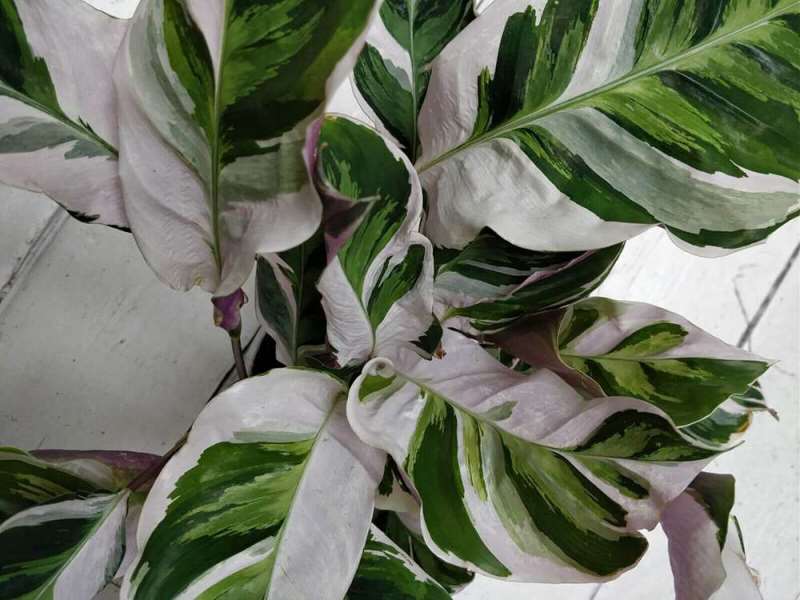
Cultivated calathea varieties
As mentioned above, there are a huge number of species of the genus Calathea that grow in natural conditions. But due to the fact that this plant is very capricious, requires special conditions for growing, not all of them are cultivated. Nevertheless, the selection of “tamed” tropical beauties is quite wide. Consider the most popular homemade varieties, but first let’s figure out how to correctly interpret their names.
26 Calathea Varieties for indoor
Currently, there are slightly more than two dozen varieties, the planting material of which is easy to find on sale. Among them, the following stand out:
Calathea saffron
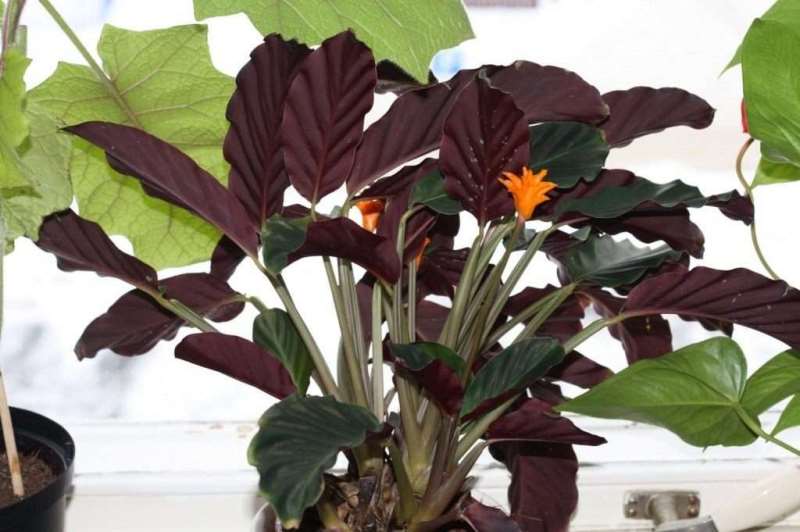
Saffron calathea (Calathea crocata). Small (about 40 cm in height), compact plant, decorative leaves much inferior to their relatives. Its peculiarity is that it is the only cultivated species of calathea that blooms regularly at home.
Calathea lancifolia
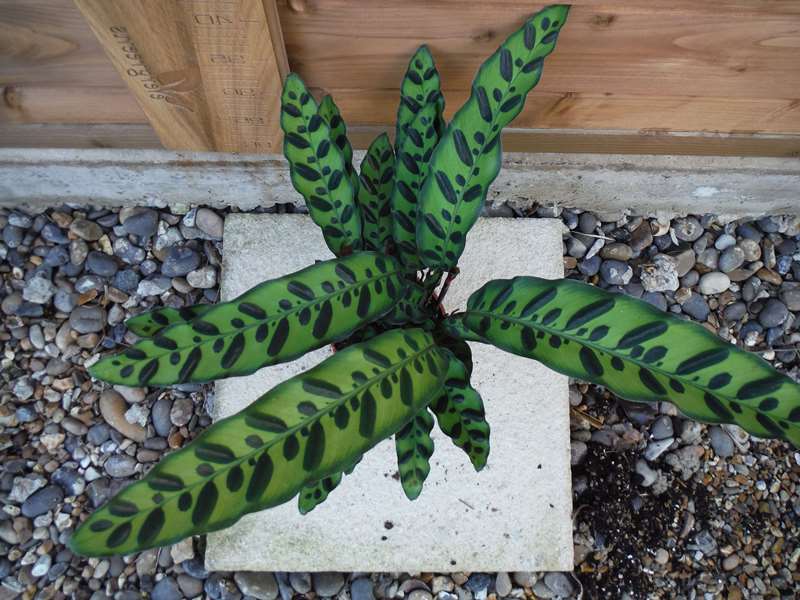
Calathea is wonderful (Calathea lancifolia, Calathea insignis) . Differs in long (up to 45 cm in length) narrow lanceolate leaves. They are dense, opaque with a pattern, in the form of oval spots of different sizes, diverging to the sides from the central vein.
Calathea makoyana
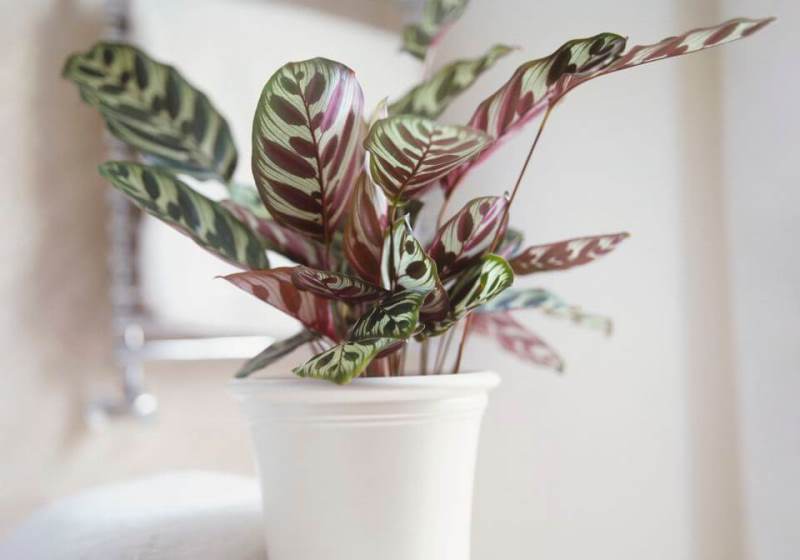
Calathea makoyana. It grows to a height of 60 cm and above. On the green obverse, the greenish-white side has a pattern of stripes and spots of various shapes, sizes, and shades of green.
Calathea orbifolia
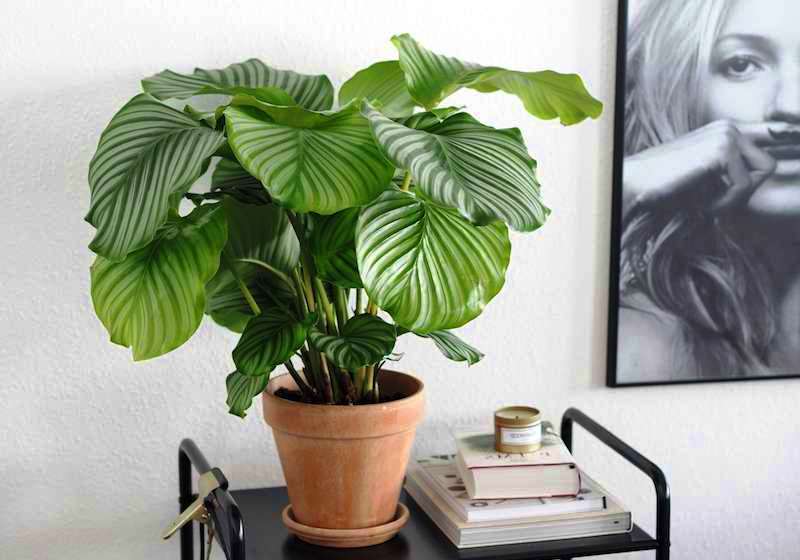
Calathea orbifolia. It grows up to 40-60 cm. The leaves have an almost regular rounded shape. Stripes diverge on both sides of the central vein, forming a very beautiful striped pattern on the surface.
Calathea medallion

Calathea medallion (Calathea roseopicta) or pink-colored calathea. A compact plant, rarely exceeding 30×30 cm in size. The leaves are oval-ovate, with a clear pattern (different depending on the variety) and well-visible reddish veins.
Calathea Warscewiczii
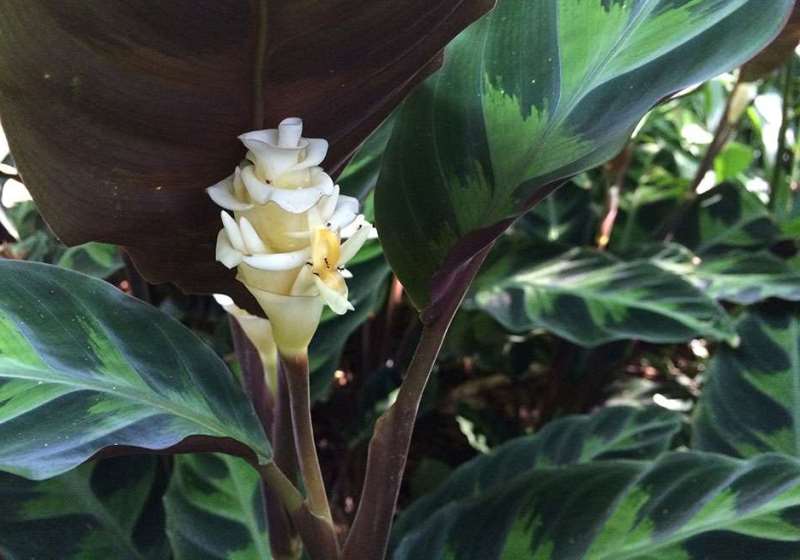
Calathea Warscewiczii. A large plant, reaching a height of up to 1 m. The leaves are velvety, in the form of an elongated oval, with a pattern symmetrical relative to the central vein, colored in several shades of green. With good care, it can bloom at home.
Calathea musaica
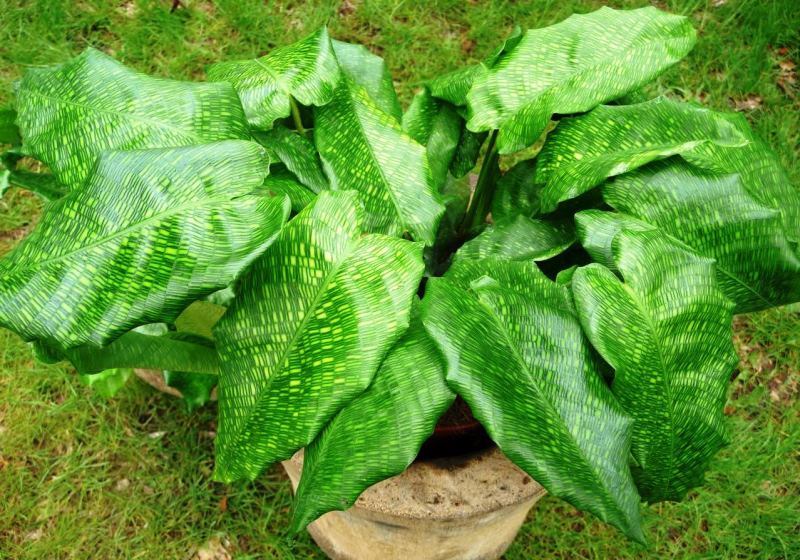
Calathea network or Calathea musaica. A low, spreading bush with a pronounced personality. The pattern on the smooth, spear-shaped leaves resembles a mosaic or mesh. Better than other species, it takes root in the apartment and tolerates wintering.
Calathea zebrina
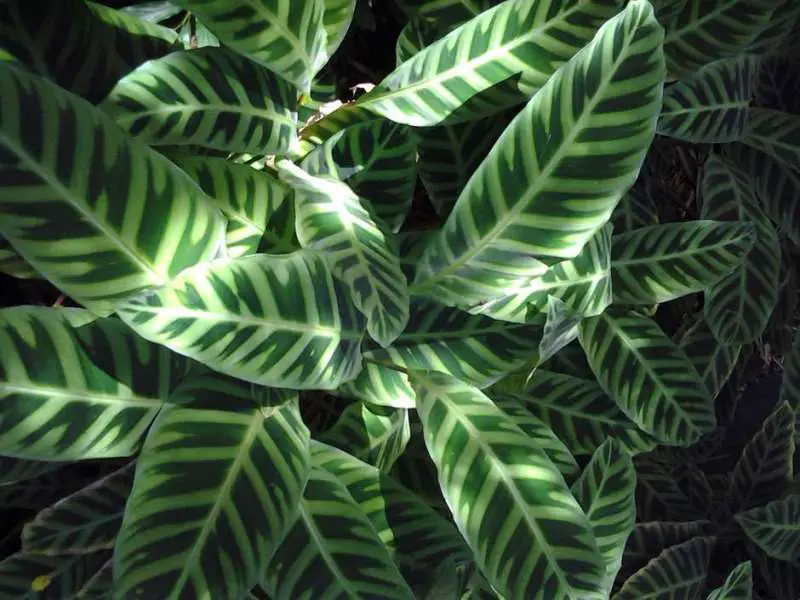
Calathea zebrina. Slender plant, up to 60 cm high, with large oval or ovoid leaves with a velvety surface. The pattern consists of dark and light stripes extending to the sides from the central vein, vaguely resembling the pattern on the skin of a zebra.
Calathea ornate
Calathea ornate. Grows up to 80 cm in height. Differs in large, up to 25 cm in length, elliptical leaves. It is considered one of the most decorative species due to its colorful, spectacular pattern of thin lines, it has several forms, the most popular of which is Calathea ornate ‘sanderiana’ – a calathea decorated with sanderiana.
Calathea rufibarba
Calathea rufibarba or red-bearded calathea. Reaches up to 1 m in height. The name is due to the red cannon on the back of the lanceolate erect leaves. The pattern on them is either absent or not pronounced.
Calathea Bachemiana
Calathea Bachemiana. It is considered one of the most capricious in care. It grows up to 40 cm. Differs in large (up to 25 cm in length) leathery leaves lanceolate leaves. The pattern on them resembles a drawing of a neat dark green twig on a light green background.
painted calathea
Calathea picturata or painted calathea. It grows up to 35–40 cm. The leaves are regular, oblong oval, with a pointed tip, the underside is purple, the upper side is silvery with a dark green border. One gets the impression that a smaller sheet is painted on a dark green leaf with silver paint. It dies at temperatures below 16 ° C. C. Picturata has been awarded an annual Garden Merit, which means it is recommended by the Royal Horticultural Society for home cultivation.
Silver calathea
Silver calathea (calathea argyraea). The first scientific description of this species was given in 1862. A compact plant with small oval leaves with a pointed tip. Their distinctive feature is an unusual silver shade. The obverse is barely noticeably corrugated with light transverse veins, which diverge parallel to each other to the sides from the center. There is a very thin green border around the edge. The back and petioles are purple.
Calathea Helen Kennedy
Calathea Helen Kennedy. It was first discovered and described by the English botanist Helen Kennedy in Panama. A short, compact plant with small oval leaves. With their bright and intricate design, they resemble peacock feathers. The front side is painted in emerald green and silver colors, the back side and petioles are crimson pink. It blooms with small yellow spike-shaped inflorescences.
Calathea white star
Calathea white star, also called calathea majestica and calathea albolineata. It was first described in 1986 by H.A. Kenn. It can grow up to 1 meter in height. Large lanceolate glossy leaves, located on long petioles. On the underside, the leaf is beet-red, and the upper part is dark green with white, sometimes pinkish-white strokes.
Calathea beauty star
Calathea beauty star. Lush compact plant. Due to its small size and large, dense green mass, its stem is not visible at all. Leaves of medium size, oval, slightly elongated with a pointed tip, divided into two halves by a thin lime vein. The drawing on the outside resembles bright green feathers painted on a dark green background. The back and short petioles are purple-violet.
Calathea flamestar
Calathea flame star. The compactness and splendor of the bush, as well as the shape of the leaves, resembles c. beauty star. But its smooth glossy leaves are larger, and their pattern is even more intricate – a complex, multi-stage edging runs along the wavy edges. In general, the drawing looks like the edges of the leaves are on fire, justifying the name “Flaming Star”. The upper side of the leaves is dark green with bright light green feather-like strokes, symmetrically diverging to the sides from a thick light green vein. The lower one, like the short petioles, is purple-beetroot.
Calathea Vicha
Calathea Veitchiana or Veitch. A tall plant, reaching a height of up to 1 m. This species was discovered in 1862 in Ecuador by the botanist Richard Pearce and named after his employer, the famous British gardener James Veach. The leaves of Calathea Vich are large, dense, glossy, oval in shape, with a pointed tip, wavy edges and a heart-shaped base, grow on long petioles. The front side is three-colored: yellowish-green, dark green and white with a complex pattern. One gets the impression that another smaller sheet is drawn on top of the main sheet. Its contours are visible on the seamy purple side. Under natural conditions, it blooms with small white or cream spike-shaped inflorescences with greenish bracts.
In 1983, in Peru, N.A. Kenn described a new species of Calathea, which has the same leaf pattern and was previously mistakenly identified in collections as C. veitchiana. This new species was named C. Pseudoveitchiana. Calathea Pseudoveichiana has a thick green border at the edges, and the pattern can consist of several colors. The varieties in which the pattern consists of white and red colors, and the frame has a bright green color, look especially bright. The pattern itself is similar to the drawing of Calathea Veich, only the “drawn” leaf has a double frame: a common one along the edge and a reddish-green inside.
Calathea Lietzei
Calathea Lietzei. It grows up to 60 cm. The leaves are in the shape of an elongated ellipse, with a slightly wavy edge, a pointed tip and a heart-shaped base, growing up to 15 cm in length and 6 cm in width. The front surface is smooth, glossy with a metallic sheen and asymmetrical pattern in the form of yellow-green strokes on a dark green background, extending to the sides from the central vein. The back and long petioles are violet-lilac. In nature, it blooms with small nondescript spike-shaped inflorescences of white color.
Calathea Freddy
Calathea Freddy. A compact ornamental houseplant up to 40 cm high. Smooth lanceolate leaves with a slightly wavy edge grow on long petioles. The upper side of the leaf is painted in a pastel whitish-green background, on top of which a dark green pattern is “applied” in the form of a twig with leaves extending to the sides from the central vein. The edges of the leaves are framed with a neat thin dark green border. This pattern is also visible on the underside, the purple-lilac side. Does not bloom at home.
Calathea Bicajoux Gecko
Calathea Bicajoux Gecko. It stretches up to 50 cm in height. It is distinguished by large, dense, glossy leaves growing on long petioles. The drawing of the leaves is unusual: it seems that another smaller emerald green leaf is painted on a large silvery-green leaf, or a dark green lizard has perched. The shade of the back of the leaves is reddish. Calathea Bikazu is one of the few blooming indoors. Small, spiky pink flowers bloom mainly in summer for 8 weeks.
Calathea Louisae
Calathea Louisae. It grows up to 40-80 cm in height. The leaves are large, thin, lanceolate, with a slightly wavy edge, up to 22 cm long and up to 10 cm wide, sitting on long petioles. The outer side is painted in three shades of green, which run in stripes resembling sloppy brush strokes from the central vein to the edges. The back is purple-violet. At home, it blooms reluctantly, with small white flowers with greenish bracts, collected in spike-shaped inflorescences. In this case, the flowering stem is much shorter than the petiole.
Calathea Queen of Maui
Calathea Louisae ‘Maui Queen’ – one of the varieties of Calathea Louise. A very showy plant with large dark green leaves on long petioles. White spike-like streaks run along the entire length of the plates along the middle vein. The seamy side is purple-violet. It grows up to 50-60cm.
Calathea Lubbers
Calathea Lubbersii. A spreading bush that grows up to 60-80 cm. It differs in the shape and color of leaves that are atypical for kalata. Smooth, glossy, oblong, they grow on very long petioles. They are not symmetrical, as in most representatives of the genus, but a chaotic pattern, consisting of yellow spots of different sizes, diverging in an arbitrary order from the central vein along a bright green surface. In addition, the underside, like the petioles, is not reddish or purple, but green.
Calathea white tiger
Calathea fusion white. A very spectacular plant that can grow up to 70-80 cm. Leaves of calathea white fusion are distinguished by an unusual, memorable marble color, consisting of white and several shades of green. The leaf plates are large, oval, with edges slightly curving in different directions, growing on long lilac petioles. On the reverse side of the plates, a marble pattern can also be traced, but this time from shades of pink, lilac and violet colors.
Calathea leopardina
Calathea leopardina. It grows up to 40-50 cm. Calathea Leopardovaya is distinguished by elliptical-lanceolate leaves, 3-5 cm wide and 10-12 cm long on long petioles. The upper side of the leaf blades is light green with dark green spots, repeating the shape of the leaves, with the base directed away from the midrib. It seems that a neat dark green twig is drawn on the light green surface. The back of the leaves is lilac-pink. In nature, it blooms with small spike-shaped yellow inflorescences.
Calathea mix
Calathea mix. Some sources mistakenly describe these calatheas as an independent species. In fact, as such, the variety or type of “Mix” does not exist. This word must be understood in a literal translation – mixing. Calathea Mix means that different species were brought to the store mixed, that is, this is just a designation for a mixture of plants.